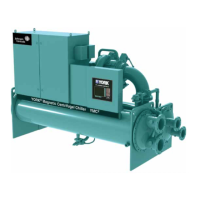JOHNSON CONTROLS
25
Form 160.78-O1
Issue date: 05/19/2021
4
Section 4 - Troubleshooting
Table 3 - Operation analysis chart
Results Possible cause Remedy
1. Symptom: abnormally high discharge pressure
Temperature dierence between
condensing temperature and water o
condenser higher than normal.
Condenser tubes dirty
or scaled.
Clean condenser tubes. Check water conditioning.
High discharge pressure.
Condenser tubes dirty
or scaled.
Clean condenser tubes. Check water conditioning.
High condenser water
temperature.
Reduce condenser water inlet temperature. Check
cooling tower and water circulation.
Temperature dierence between condenser
water on and water o higher than normal,
with normal evaporator pressure.
Insucient
condensing water ow.
Increase the quantity of water through the
condenser to the correct value.
2. Symptom: abnormally low suction pressure
Temperature dierence between leaving
chilled water and refrigerant in the
evaporator greater than normal with normal
discharge temperature.
Insucient charge of
refrigerant.
Check for leaks and charge refrigerant into system.
Variable orice
problem.
Remove obstruction.
Temperature dierence between leaving
chilled water and refrigerant in the
evaporator greater than normal with normal
discharge temperature.
Evaporator tubes dirty
or restricted.
Clean evaporator tubes.
Temperature of chilled water too low with
low motor amperes.
Insucient load for
system capacity.
Check capacity control operation and setting of low
water temperature shutdown setpoint.
3. Symptom: high evaporator pressure
High chilled water temperature.
Capacity control failed
to load.
Check the PRV (if applicable), VGD, and hot gas
bypass (if applicable) positioning circuits.
System overload.
Be sure the capacity control devices and speed
increased (without overloading the motor) until the
load decreases.

